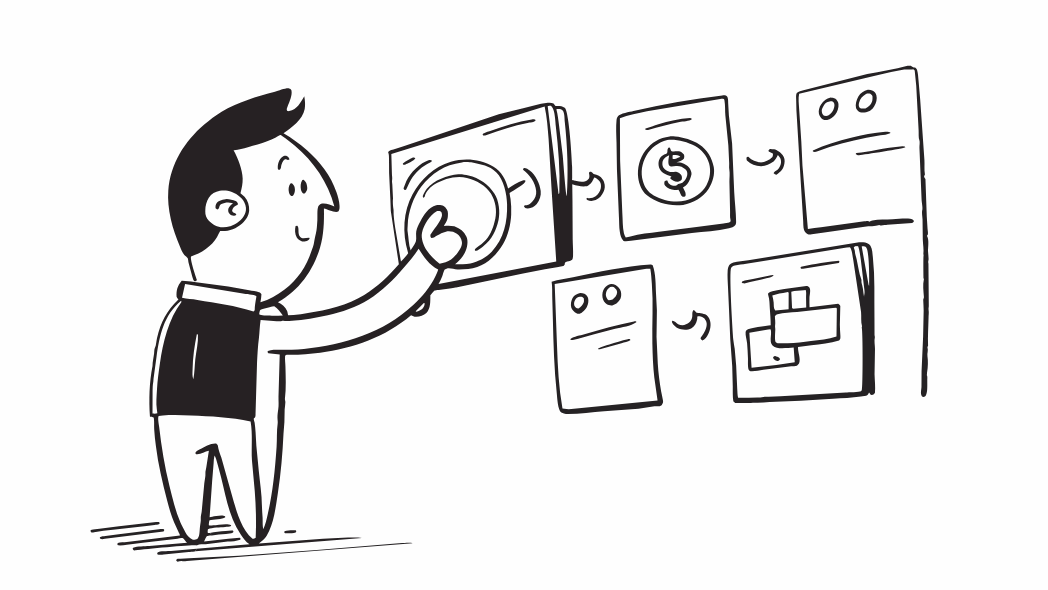Introduction to Cash Flow Management: The Royal Family of Your Business Finances
Listen up, oh industry captain! You might think you’re the boss of your SME, but let’s pull back the curtain on who’s really calling the shots. Spoiler alert: it’s not you. It’s that dynamic duo of Cash and Cash Flow. Think of them as the power couple of your business world – Cash is the charismatic King who gets all the attention, but Cash Flow? She’s the Queen who’s really running the show behind the scenes.
Now, before you start feeling like you’re trapped in a fiscal version of “Game of Thrones,” let’s break down why you need to cosy up to this royal family, especially if you want your business to have a happier ending than the Red Wedding.

Cash is King, Cash Flow is Queen. You know who runs the show!
Importance of Cash Flow Management for SMEs: Your Business’s Life Support System
Imagine your business is a dragon (stick with me here). Cash is the fire it breathes – impressive, scary, and great for barbecues. But Cash Flow? That’s the blood pumping through its veins, keeping it alive and kicking. You can have all the fire-breathing cash in the world, but if that life-giving cash flow stops… Well, let’s just say even Daenerys Targaryen couldn’t save you then.
“Your profit and loss statement is your fairy tale. Your cash flow statement? That’s your reality show – unscripted, unpredictable, and occasionally terrifying.”
For SMEs, managing cash flow isn’t just important; it’s the difference between being the next big thing and being the next big cautionary tale at a business school. It’s what keeps the lights on, the staff paid, and the coffee flowing (priorities, people!). Without it, you’re just playing business dress-up in your mom’s basement.
Understanding Cash Flow Cycles in SMEs: The Circle of (Business) Life
Picture this: Money comes in, money goes out. Simple, right? Wrong! If you think your cash flow cycle is that straightforward, you might as well believe in unicorns and risk-free investments.

In reality, your cash flow cycle is more like a roller coaster designed by a caffeinated toddler. You’ve got money coming in from sales (hopefully), going out for expenses (definitely), and playing hide-and-seek in between. Understanding this cycle is like being the conductor of a very complicated, potentially off-the-rails train. You need to know when the cash is coming, where it’s going, and how to scream for help when it all goes sideways.
Cash Flow Forecasting Techniques: Because Your Crystal Ball is in the Shop
Wouldn’t it be nice if predicting your cash flow was as easy as reading tea leaves or consulting a Magic 8 Ball? Sadly, unless “Outlook not so good” is the financial insight you’re after, you’ll need to get a bit more sophisticated.
Cash flow forecasting is part science, part art, and part wishful thinking. Start with your historical data (because past performance is totally a guarantee of future results, right?), add in some educated guesses about the future, sprinkle in a dash of market trends, and voila! You’ve got yourself a forecast that’s slightly more reliable than predicting the weather in London.
Key techniques include:
- The “Squint and Hope” Method: Just kidding. (Maybe.)
- Rolling Forecasts: Because the only constant is change, and your cousin’s wedding next month.
- Scenario Planning: AKA the “What If” game for grown-ups with spreadsheets.
Remember, the goal isn’t to be psychic; it’s to be prepared. Think of it as a financial storm chasing – you might not prevent the tornado, but at least you’ll know when to hide in the basement.
Strategies for Managing Accounts Receivable: The Art of Polite Arm-Twisting
Ah, accounts receivable – the promised land of money that’s technically yours but seems to be on an extended vacation in someone else’s bank account. Managing this is like herding cats, if the cats owed you money and had really good excuses.
“Managing cash flow is like herding cats. Except the cats are made of money, they’re invisible, and everyone wants to pet them. Good luck!”
Here’s your game plan:
- Invoice Promptly: The early bird gets the worm, and the early invoice gets the payment. Maybe.
- Clear Payment Terms: Spell it out like you’re explaining it to a five-year-old. A five-year-old who controls your cash flow.
- Follow Up: Be the squeaky wheel. The polite, professional, slightly annoying squeaky wheel.
- Incentivize Early Payments: Carrots work better than sticks, especially when the carrots are discounted.
- Automate Reminders: Because your time is better spent than playing email tag with Bob from accounting.
Remember, the goal is to get paid without burning bridges. Think less “Godfather” and more “persistent golden retriever.”
Best Practices for Accounts Payable Management: The Delicate Dance of Keeping Your Money Longer
Welcome to the other side of the coin – where you’re the one holding onto the cash. Accounts payable management is like a high-stakes game of hot potato. Hold onto the money too long, and you might lose suppliers. Let it go too quickly, and your bank account will give you the side-eye.
Best practices include:
- Negotiate Payment Terms: Flex those negotiation muscles. Your suppliers want a long-term relationship, not a one-night stand.
- Set Up a Payment Schedule: Structure is sexy, especially in finance.
- Use Technology: Because manually writing checks is so last century.
- Take Advantage of Discounts: Early payment discounts are the closest thing to free money you’ll ever see.
- Maintain Good Supplier Relationships: Today’s late payment could be tomorrow’s inventory shortage.
The key is to find that sweet spot where you can maximise your cash flow without becoming Ebenezer Scrooge of the business world.
Managing Inventory for Better Cash Flow: Because Money Gathering Dust is Sad
Inventory: Can’t live with it, can’t live without it. It’s like that high-maintenance friend who’s always crashing on your couch and eating all your food. Except in this case, the couch is your warehouse, and the food is your cash flow.
Here’s how to keep your inventory from becoming a cash flow black hole:
- Just-in-Time Inventory: Because psychic powers are more reliable than your demand forecasts.
- Regular Stock Takes: Know what you have, unless you enjoy surprise parties thrown by your balance sheet.
- Identify Slow-Moving Items: If it’s moving slower than a sloth on vacation, it’s time to say goodbye.
- Use Technology: Spreadsheets are cool, but have you tried inventory management software?
- Negotiate with Suppliers: Flexibility is key. Your suppliers should be partners, not pen pals.
Remember, the goal is to have enough inventory to meet demand without turning your warehouse into a cash storage facility. It’s a balancing act worthy of Cirque du Soleil.
Cost Control Strategies for SMEs: Trimming the Fat Without Becoming Anorexic
Cost control in an SME is like trying to diet while working in a chocolate factory. It’s necessary, it’s hard, and there’s temptation everywhere. But fear not! With these strategies, you’ll be the picture of financial health in no time.
- Audit Your Expenses: Go through your expenses like you’re Marie Kondo. If it doesn’t spark joy (or profit), thank it and let it go.
- Negotiate Everything: Your suppliers, your landlord, that guy selling pencils on the corner. Everything is negotiable.
- Embrace Technology: If there’s a cheaper, faster, automated way to do something, jump on it like it’s the last lifeboat on the Titanic.
- Energy Efficiency: Save the planet, save money. It’s a win-win, unless you’re in the coal business.
- Review Subscriptions and Services: Do you really need 17 different project management tools? (Spoiler: You don’t.)
The trick is to cut costs without cutting corners. You want to be lean and mean, not emaciated and hallucinating.
Financing Options for SMEs: Because Sometimes You Need a Little Help from Your (Financial) Friends
Sometimes, despite your best efforts, your business bank account looks emptier than a salad bar at a burger festival. That’s when it’s time to explore financing options. But beware – the world of business financing is like a jungle, filled with predators, quicksand, and the occasional helpful monkey.
Your options include:
- Bank Loans: Traditional, boring, and sometimes about as easy to get as a ticket to the moon.
- Line of Credit: For when you need financial flexibility and a reason to stay up at night worrying.
- Invoice Financing: Sell your invoices! It’s like a garage sale for your accounts receivable.
- Crowdfunding: Because nothing says “I believe in my business” like asking strangers online for money.
- Venture Capital: For when you’re ready to trade a piece of your soul for a bucket load of cash and some “helpful advice.”
Choose wisely. The right financing can be a lifeline; the wrong one can be an anchor. And remember, just because you can doesn’t mean you should. Debt is like fire – useful when controlled, disastrous when not.
Improving Cash Flow through Sales and Marketing: Making It Rain (Financially Speaking)
Here’s a revolutionary idea: to improve cash flow, try selling more stuff! I know, mind-blowing, right? But seriously, boosting your sales and marketing efforts can be like turning on a cash flow fire hose. Just make sure you’re pointing it in the right direction.
Strategies to consider:
- Upsell and Cross-sell: “Would you like fries with that?” but for your business.
- Customer Retention: It’s cheaper to keep a customer than find a new one. Plus, they already know where to send the money.
- Diversify Your Customer Base: Don’t put all your eggs in one basket, unless you’re in the egg basket business.
- Optimise Your Pricing: Too low, and you’re leaving money on the table. Too high, and you’re leaving customers on the table.
- Targeted Marketing: Spray and pray is for garden hoses, not marketing budgets.
Remember, the goal is to bring in more cash without spending all your existing cash. It’s a delicate balance, like a tightrope walker carrying a bag of money. Over a pit of hungry accountants.
Managing Cash Flow during Expansion: Growing Pains that Don’t Require Painkillers

Expanding your business is exciting! It’s also terrifying, especially for your cash flow. It’s like trying to stretch a rubber band – exciting until it snaps and hits you in the face. Here’s how to expand without your cash flow throwing in the towel:
- Plan, Plan, Plan: And then plan some more. Forecasting isn’t just for weather channels.
- Staged Expansion: Rome wasn’t built in a day, and unless you’re Jeff Bezos, your business expansion shouldn’t be either.
- Keep a Cash Reserve: It’s your financial safety net. Without it, expanding is like skydiving without a parachute.
- Monitor Cash Flow Closely: Keep an eye on it like a hawk. A very nervous, spreadsheet-loving hawk.
- Secure Financing Early: Waiting until you need it is like buying flood insurance when you’re neck-deep in water.
Expansion is a game of calculated risks. Calculate well, or risk becoming a cautionary tale at the next small business seminar.
Dealing with Cash Flow Challenges and Crisis: When the Stuff Hits the Fan
Even the best-laid plans of mice and business owners often go awry. When cash flow challenges hit, it’s time to channel your inner MacGyver. Here’s your financial Swiss Army knife:
- Prioritise Payments: It’s like triage, but for bills. Who gets paid first? (Hint: It’s probably not that fancy coffee machine lease.)
- Negotiate with Creditors: They’d rather get some money than no money. Use this to your advantage.
- Boost Sales: Have a flash sale. Offer discounts. Sell a kidney. (Okay, maybe not that last one.)
- Cut Non-Essential Costs: Anything that doesn’t keep the lights on or the revenue flowing is on the chopping block.
- Seek Short-Term Financing: But be careful – it’s a lifeline, not a lifestyle.
Remember, cash flow crises are like bad weather – they’ll pass. Your job is to make sure your business is still standing when the sun comes out.
Automation and Technology for Cash Flow Management: Welcome to the 21st Century, Your Cash Flow Will Thank You
If you’re still managing your cash flow with a pencil, paper, and prayer, it’s time to join the digital age. Automation and technology are like having a tireless, mistake-free assistant who never asks for raises or vacations.
Consider:
- Accounting Software: Because Excel spreadsheets are so last millennium (XERO, MYOB, QuickBooks, etc)
- Automated Invoicing: Let the robots chase your money for you.
- Cash Flow Forecasting Tools: Like a crystal ball, but with algorithms.(try Fathom, Calxa, CashFlow Story, etc)
- Payment Processing Systems: For when you want to get paid faster than you can say “cha-ching.”
- Inventory Management Software: Because counting by hand is for kindergarteners, not business owners.
Embrace the machines. They’re here to help, not take over. (At least, that’s what they want us to think.)
Cash Flow Management Metrics and KPIs: Numbers that Actually Mean Something
Drowning in data? Not all numbers are created equal.
“Cash flow is like oxygen – you don’t notice it until it’s gone, and then it’s all you can think about. Breathe easy, or die trying.”
Here are the golden metrics that’ll tell you if your cash flow is a roaring river or a trickling stream:
- Operating Cash Flow Ratio: Are you generating enough cash to cover short-term liabilities? (If not, start sweating.)
- Cash Conversion Cycle: How long does it take for a dollar spent to come back as revenue? (Shorter is better unless you’re ageing fine wine.)
- Days Sales Outstanding: How long are your customers taking to pay? (If it’s longer than your patience, you’ve got a problem.)
- Free Cash Flow: What’s left after all the bills are paid? (Hopefully, more than enough for a celebratory drink.)
- Cash Flow Forecast Accuracy: How good are you at predicting the future? (If you’re spot on, please share next week’s lottery numbers.)
These metrics are your cash flow dashboard. Keep an eye on them, or risk driving your business off a financial cliff.
Developing a Cash Flow Management Plan: Your Roadmap to Financial Sanity
Alright, you’ve made it this far. You’re armed with knowledge, wit, and possibly a slight headache from all this financial talk. Now it’s time to put it all into a cash flow management plan. Think of it as your business’s financial GPS.
Your plan should include:
- Regular Forecasting: Because the future waits for no one, especially not procrastinating business owners.
- Clear Policies: For billing, payments, and that one employee who keeps “forgetting” to submit expense reports.
- Emergency Procedures: What to do when cash flow hits the fan. (Step 1: Don’t panic. Step 2: Refer to this guide.)
- Technology Integration: Embrace the robots. They’re here to help.
- Review and Adjust: Because the only constant in business is change. And taxes. Always taxes.
Remember, a cash flow management plan is a living document. It should evolve as your business grows, pivots, or occasionally stumbles.
In conclusion, mastering cash flow management is like learning to juggle while riding a unicycle – it takes practice, concentration, and a willingness to look silly occasionally. But get it right, and you’ll be the star of the small business circus.
Now go forth, intrepid entrepreneur!


